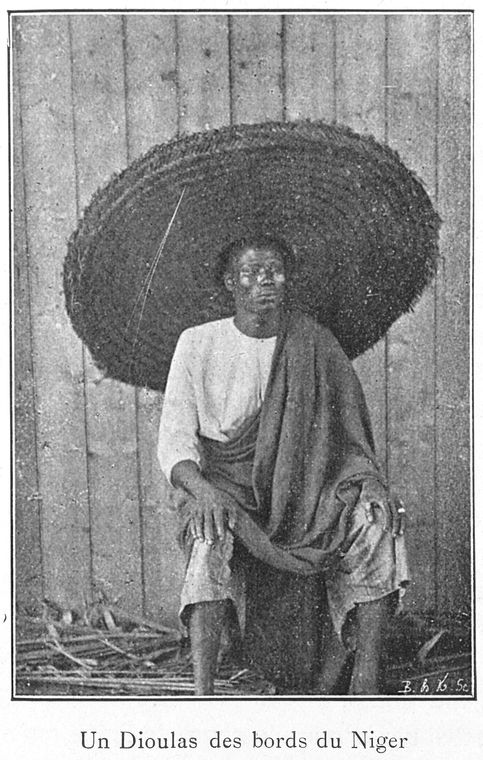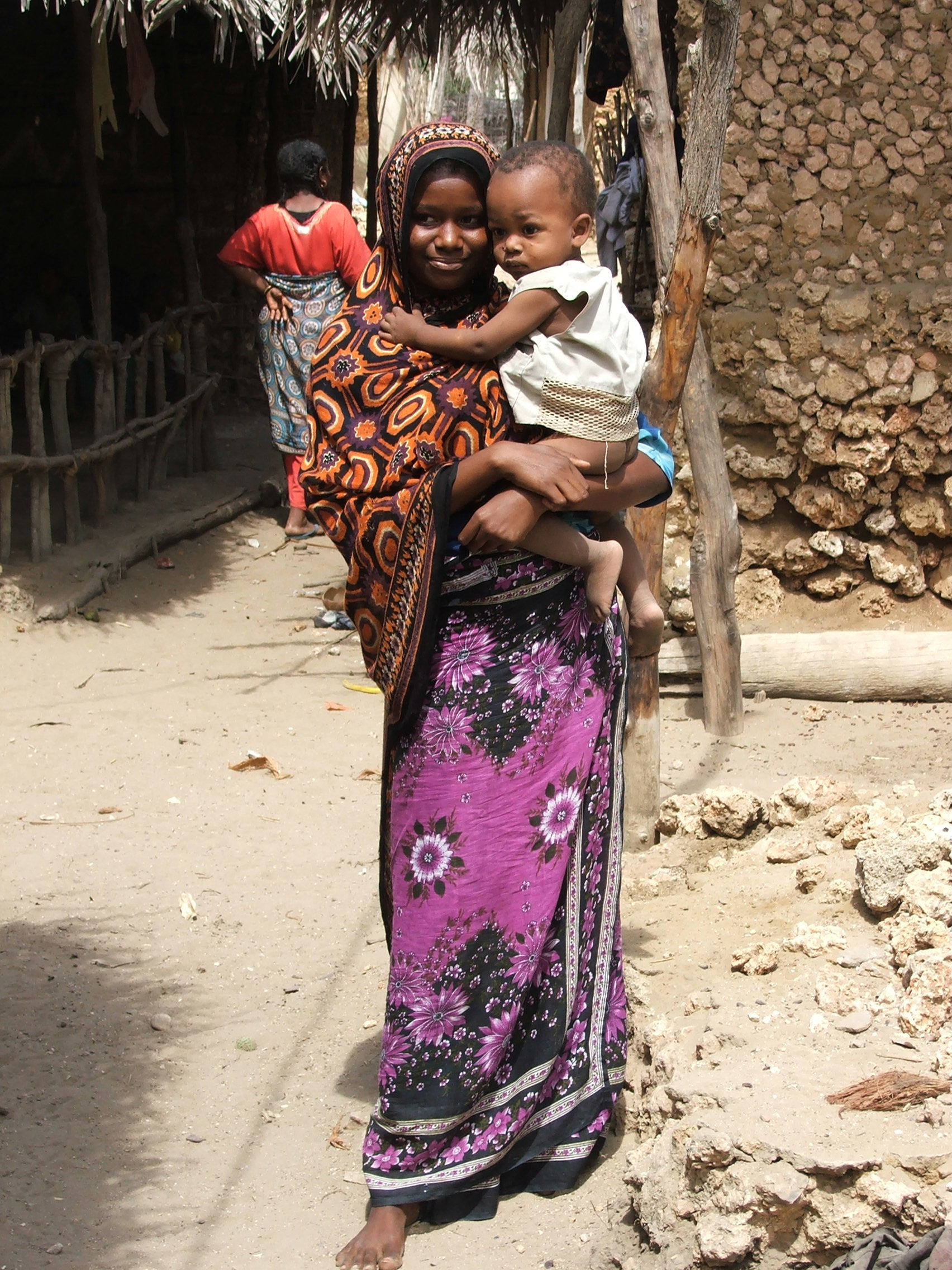|
Korhogo Cloth
Korhogo cloth is an African textile made by the Senufo people of Korhogo, Ivory Coast. Often described as being in the shadows of bogolafini (mud cloth) and kente, korhogo comes in neutral and earthy tones like browns, blacks and creams. Korhogo is made by hand painting designs on hand woven and hand spun cotton fabric. The paintings are done using a specially fermented mud-based and natural vegetal pigment that darkens over time, and designs are usually drawn on using a stencil. They are decorated with symbols of humans, natural elements like the sun, moon and stars and animals, all of which are rooted in Senufo culture and mythology. The Senufo use the cloth as a shield against vengeful spirits by wearing or hanging them in homes/shrines. Korhogo is commissioned for hunters (important heroic figures) and rite of passage events like funerals/special ceremonies. Men and women are involved in the fabrication of the cloth. Both cultivate the cotton, the women spin the cotton into ... [...More Info...] [...Related Items...] OR: [Wikipedia] [Google] [Baidu] [Amazon] |
Senufo People
The Senufo people, also known as Siena, Senefo, Sene, Senoufo, and Syénambélé, are a West African ethnolinguistic group. They consist of diverse subgroups living in a region spanning the northern Ivory Coast, the southeastern Mali and the western Burkina Faso. One sub-group, the Nafana, is found in north-western Ghana. The Senufo people are predominantly animists, with some who are Muslims. They are regionally famous for their handicrafts, many of which feature their cultural themes and religious beliefs. Demographics and languages In the 1980s, estimates placed the total ethnic group population of Senufo people somewhere between 1.5 and 2.7 million. A 2013 estimate places the total over 3 million, with majority of them living in Ivory Coast in places such as Katiola, and some 0.8 million in southeastern Mali. Their highest population densities are found in the land between the Black Volta river, Bagoe River and Bani River. Their kinship organization is matrilineal. Ty ... [...More Info...] [...Related Items...] OR: [Wikipedia] [Google] [Baidu] [Amazon] |
Korhogo
Korhogo (N'Ko: ߞߙߐߞߐ߫, ''Krokо̄'') is a city in northern Ivory Coast. It is the seat of both Savanes District and Poro Region. It is also a commune and the seat of and a sub-prefecture of Korhogo Department. In the 2014 census, the city had a population of 243,048, making it the fourth-largest city in the country and the largest in northern Ivory Coast. Korhogo produces goods such as cotton, kapok fibre, rice, millet, peanuts, corn, yams, sheep, goats and diamonds. The settlement was on an important pre-colonial trade route to the Atlantic coast. It is said to have been founded by Nangui, a 14th-century Senufo patriarch and still is the capital of the Senufo people. Sights in Korhogo include the Péléforo Gbon Coulibaly Regional Museum and the woodcarvers' quarter. Korhogo is also home to an airport, a large market, a cinema, and a mosque. Korhogo's average annual rainfall is 1,243 mm, with the rainiest months being May to October. Its average year-round temp ... [...More Info...] [...Related Items...] OR: [Wikipedia] [Google] [Baidu] [Amazon] |
Bògòlanfini
Bògòlanfini or bogolan (; "mud cloth"; sometimes called mud-dyed cloth or mud-painted cloth in English language, English) is a handmade Malian cotton fabric traditionally dyed with fermented mud. It has an important place in traditional Malian culture and has, more recently, become a symbol of Malian cultural identity. The cloth is exported worldwide for use in fashion, fine art and decoration. Origins and etymology The dye technique is associated with several Malian ethnic groups, but the Bambara people, Bamana version has become best known outside Mali. In the Bambara language, the word ''bògòlanfini'' is a composite of ''bɔgɔ'', meaning "earth" or "mud"; ''lan'', meaning "with" or "by means of"; and ''fini'', meaning "cloth". Although usually translated as "mud cloth," ''bògòlan'' actually refers to slip (ceramics), slip clay with a high iron content. The iron in the clay will stain handspun and handwoven cotton textiles black (color), black. Production The center of ... [...More Info...] [...Related Items...] OR: [Wikipedia] [Google] [Baidu] [Amazon] |
Kente Cloth
Kente refers to a Ghanaian textile made of hand-woven strips of silk and cotton. Historically the fabric was worn in a toga-like fashion among the Asante, Akan and Ewe people. According to Asante oral tradition, it originated from Bonwire in the Ashanti Region of Ghana. In modern day Ghana, the wearing of kente cloth has become widespread to commemorate special occasions, and kente brands led by master weavers are in high demand. Due to the popularity of kente cloth patterns, production of mass-produced prints with the kente patterns have become popular throughout West Africa, and by extension the whole of Africa. Globally, the print is used in the design of academic stoles in graduation ceremonies worn mostly by black people in the United States and Canada. Etymology Kente comes from the word ''kɛntɛn'', which means "basket" in the Asante dialect of the Akan language, referencing its basket-like pattern. In Ghana, the Akan ethnic group also refers to kente as ''nwentom ... [...More Info...] [...Related Items...] OR: [Wikipedia] [Google] [Baidu] [Amazon] |
Dyula People
The Dyula (Dioula or Juula) are a Mande people, Mande ethnic group inhabiting several West African countries, including Mali, Côte d'Ivoire, Ghana, and Burkina Faso. Characterized as a highly successful merchant caste, ''Dyula'' migrants began establishing trading communities across the region in the fourteenth century. Since business was often conducted under non-Muslim rulers, the ''Dyula'' developed a set of theological principles for Muslim minorities in non-Muslim societies. Their unique contribution of long-distance commerce, Islamic scholarship and religious tolerance were significant factors in the peaceful expansion of Islam in West Africa. The term 'Dyula' is sometimes used interchangeably with Soninke Wangara, Wangara or Jakhanke people, Jakhanke, depending on the historical period and region. Historical background The Mandé embraced Islam during the thirteenth century following introduction to the faith through contact with the North African traders. By the 14 ... [...More Info...] [...Related Items...] OR: [Wikipedia] [Google] [Baidu] [Amazon] |
Poro
The Poro, or Purrah or Purroh, is a men's secret society in Sierra Leone, Liberia, Guinea, and the Ivory Coast, introduced by the Mane people (the Mandé peoples, Mande Elites leading large-scale migrations from the Mali Empire into the southern coastal areas). It is sometimes referred to as a hunting society and only men are admitted to its ranks. The female counterpart of the Poro society is the Sande society. Structure The Poro society was part of the culture introduced by Mane people, migrants to the region as early as 1000 AD.Fyfe, Christopher"Weighing the Probabilities."Review: ''Landlords and Strangers: Ecology, Society and Trade in Western Africa, 1000–1630.'' By George E. Brooks. Boulder, CO: Westview Press, 1994. Two affiliated and secret associations exist in Sierra Leone, the Yassi society, Yassi and the Sande society, Bundu. The first is nominally reserved for women, but members of the Poro are admitted to certain ceremonies. All the female members of the Yas ... [...More Info...] [...Related Items...] OR: [Wikipedia] [Google] [Baidu] [Amazon] |
Woven Fabrics
Woven fabric is any textile formed by weaving. Woven fabrics, often created on a loom, are made of many threads woven in a warp and weft. Technically, a woven fabric is any fabric made by interlacing two or more threads at right angles to one another. Woven fabrics can be made of natural fibers, synthetic fibers, or a mixture of both, such as cotton and polyester. Woven fabrics are used for clothing, garments, decorations, furniture, carpets and other uses. Production process Yarn preparation Fibers are spun into yarns and prepared with specific properties tailored for either the warp (longitudinal yarns) or the weft (transverse yarns). Warping The warp yarns are arranged on a beam to prepare for weaving. The warp threads are held taut and parallel, and as such must be strong and durable. Weaving During weaving, the weft yarn passes over and under the warp yarns in various patterns. The primary types of weaves are plain weave, Twill, twill weave, and Satin, satin weave. ... [...More Info...] [...Related Items...] OR: [Wikipedia] [Google] [Baidu] [Amazon] |
African Clothing
African clothing is the traditional clothing worn by the people of Africa. African clothing and fashion is a diverse topic that provides a look into different African cultures. Clothing varies from brightly colored textiles, to abstractly embroidered robes, to colorful beaded bracelets and necklaces. Since Africa is such a large and diverse continent, Folk costume, traditional clothing differs throughout each country. For example, many countries in West Africa have a "distinct regional dress styles that are the products of long-standing textile crafts in weaving, dyeing, and printing", but these traditions are still able to coexist with western styles. A large contrast in African fashion is between rural and urban societies. Urban societies typically are exposed more to trade and the changing world, while it takes more time for new western trends to get to rural areas. By region In Northeastern Africa, particularly in Egypt, styles of traditional women's clothing have been inf ... [...More Info...] [...Related Items...] OR: [Wikipedia] [Google] [Baidu] [Amazon] |
Culture Of Ivory Coast
The diverse culture of Ivory Coast, a coastal West African country bordered by Ghana, Liberia, Mali, Burkina Faso, and Guinea, is exemplified by a multitude of ethnic groups, events, festivals, music, and art. More than sixty indigenous ethnic groups are often cited, although this number may be reduced to seven clusters of ethnic groups, by classifying small units together on the basis of their cultural and historical characteristics, which differ somewhat from one to the next. These may be further reduced to four major cultural regions – the East Atlantic (primarily Akan), West Atlantic (primarily Kru), Voltaic, and Mandé – differentiated in terms of environment, economic activity, language, and overall cultural characteristics. In the southern half of the country, the East Atlantic and West Atlantic cultures, separated by the Bandama River, each make up almost one-third of the indigenous population. Roughly one-third of the indigenous population lives in the north, i ... [...More Info...] [...Related Items...] OR: [Wikipedia] [Google] [Baidu] [Amazon] |








